Introduction
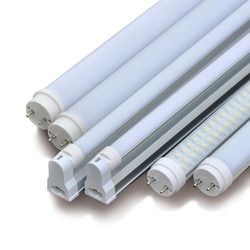 Finding the perfect tubelight can make a big difference in how your space looks and saves energy. From the classic fluorescent tubes to the newer LED options, there’s a lot to consider. In this guide, we’ll walk you through the various types of tubelights, explain their advantages, and help you figure out which one is best for your home or office. Whether you’re looking to upgrade for style or efficiency, we’ve got you covered with everything you need to know!
Finding the perfect tubelight can make a big difference in how your space looks and saves energy. From the classic fluorescent tubes to the newer LED options, there’s a lot to consider. In this guide, we’ll walk you through the various types of tubelights, explain their advantages, and help you figure out which one is best for your home or office. Whether you’re looking to upgrade for style or efficiency, we’ve got you covered with everything you need to know!
Click here to know about the evolution of Tubelights
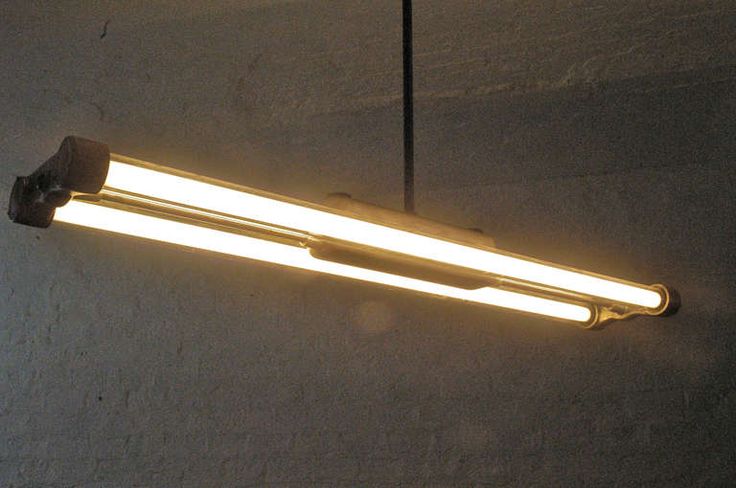
Types of Tubelights Available in the market
There are many types of tubelights that exist, which we will discuss below.
T4 tubelights
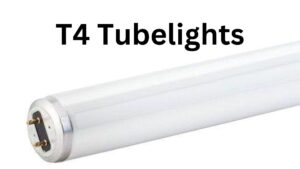
T4 fluorescent tube lights are a specific type of tubelight characterized by their compact size and energy efficiency. These tubelights have a diameter of approximately 0.5 inches (12.7 mm), which is smaller than the more common T8 and T12 tube lights. Despite their compact size, T4 tubes can emit substantial light output and are often used in spaces where slim fixtures or a more concentrated light source is needed.
Diameter
0.5 inch or 12.7 mm
Advantages
- Versatility: They can be used in a variety of settings, including commercial offices, residential spaces, retail stores, and industrial facilities, due to their compatibility with different fixture types.
- Light Quality Options: Available in various color temperatures (warm white, cool white, etc.), T4 tubelights offer flexibility in achieving desired lighting ambiance and task suitability.
- Instant Start: Many T4 tubelights feature instant start technology, providing immediate full brightness without flickering or warm-up time.
- Environmental Benefits: Their energy efficiency contributes to lower greenhouse gas emissions, aligning with environmental sustainability goals.
T5 tubelights

T5 tubelights are characterized by their narrow diameter, measuring approximately 5/8 of an inch (16 mm). This slim profile allows for more compact fixtures and provides a sleek appearance compared to older, bulkier fluorescent tubes like T8 and T12. Originally introduced as a more energy-efficient alternative to these larger tubes, T5 tubelights have become widely adopted in various commercial, industrial, and residential settings.
Diameter
5/8 inch or 16 mm
Advantages
- Energy Efficiency: T5 tubelights are designed to operate efficiently, consuming less energy than traditional fluorescent tubes. This efficiency not only reduces electricity costs but also contributes to environmental sustainability by lowering overall energy consumption.
- High Light Output: Despite their smaller size, T5 tubelights can produce significant amounts of light, making them suitable for both general illumination and task lighting applications. They are available in different wattages and lumen outputs to meet various lighting requirements.
- Long Lifespan: T5 tubelights typically have a longer lifespan compared to older fluorescent technologies. This longevity reduces maintenance needs and replacement costs, making them a cost-effective lighting solution over time.
- Versatility: These tubelights are compatible with a range of fixtures, including recessed troffers, surface-mounted fixtures, and pendant lights. Their compact size and high output make them ideal for applications where space is limited or where a modern, streamlined aesthetic is desired.
- Color Temperature Options: T5 tubelights are available in different color temperatures, ranging from warm white (3000K) to cool white (5000K and higher). This flexibility allows users to choose lighting that suits the specific ambiance or task requirements of their space.
- Instant Start Capability: Many T5 tubelights feature instant start technology, providing immediate full brightness without the flickering or warm-up time associated with older fluorescent tubes. This feature enhances user comfort and convenience in environments where instant illumination is crucial.
T8 Tubelights
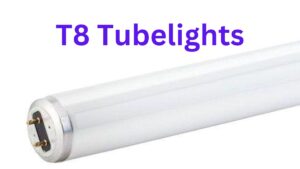
T8 tubelights are widely used fluorescent lamps known for their efficiency, versatility, and reliability. The diameter of a T8 tubelight is approximately 1 inch, which equals approximately 25.4 millimeters.
Diameter
1 inch or 25.4 mm
Advantages
- Size: Diameter of approximately 1 inch (25.4 mm).
- Efficiency: More energy-efficient than older T12 tubes, reducing electricity costs.
- Light Quality: Provides high-quality light with options for various color temperatures.
- Longevity: Lasts 20,000 to 30,000 hours, minimizing maintenance needs.
- Versatility: Suitable for diverse indoor applications like offices, schools, and retail spaces.
- Environmental Impact: Lower greenhouse gas emissions due to reduced energy consumption.
T12 tubelights
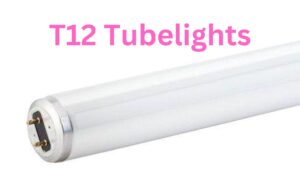
T12 tubelights were once a standard in fluorescent lighting but have become less common due to advancements in technology.
Diamater
1.5 inch or 38.1 mm
Advantages and disadvantages
- Efficiency: Compared to T8 and T5 tubes, T12 tubelights are less energy-efficient. They consume more electricity for the same light output, leading to higher operating costs.
- Light Quality: They provide adequate light output but may have poorer color rendering compared to newer fluorescent and LED options.
- Longevity: T12 tubelights typically have a lifespan of around 10,000 to 20,000 hours, shorter than T8 and LED alternatives, requiring more frequent replacements.
- Versatility: Despite their larger size, T12 tubes are still used in some older fixtures and applications where retrofitting to newer models is not feasible.
- Environmental Impact: Due to their lower efficiency, T12 tubelights contribute more to energy consumption and greenhouse gas emissions compared to newer, more efficient lighting options.
- Phasing Out: Many regions are phasing out T12 tubelights due to their inefficiency, in favor of more energy-efficient options like T8 and LED tubes.
Circlular Florescent tubes

Circular fluorescent tubes are a type of fluorescent lamp that is bent into a circular or ring shape instead of the traditional straight form of linear fluorescent tubes. They are designed to fit into fixtures specifically made for circular tubes and are commonly used in various indoor lighting applications.
Types of Circular florescent tubes
There are many Circular florescent tubes exists in the market such as
T5 Circular florescent tubes

- T5 circular fluorescent tubes are bent into a circular or ring shape, similar to other circular fluorescent tubes, but they utilize the T5 technology, which means they have a smaller diameter compared to traditional T8 and T12 tubes.
- T5 circular tubes consume less energy compared to older T12 and even T8 circular fluorescent tubes, resulting in lower electricity bills and reduced environmental impact.
- T5 circular fluorescent tubes typically have a longer lifespan compared to older fluorescent technologies. They can last between 15,000 to 30,000 hours, depending on usage conditions and maintenance practices.
T6 Circular florescent tubes
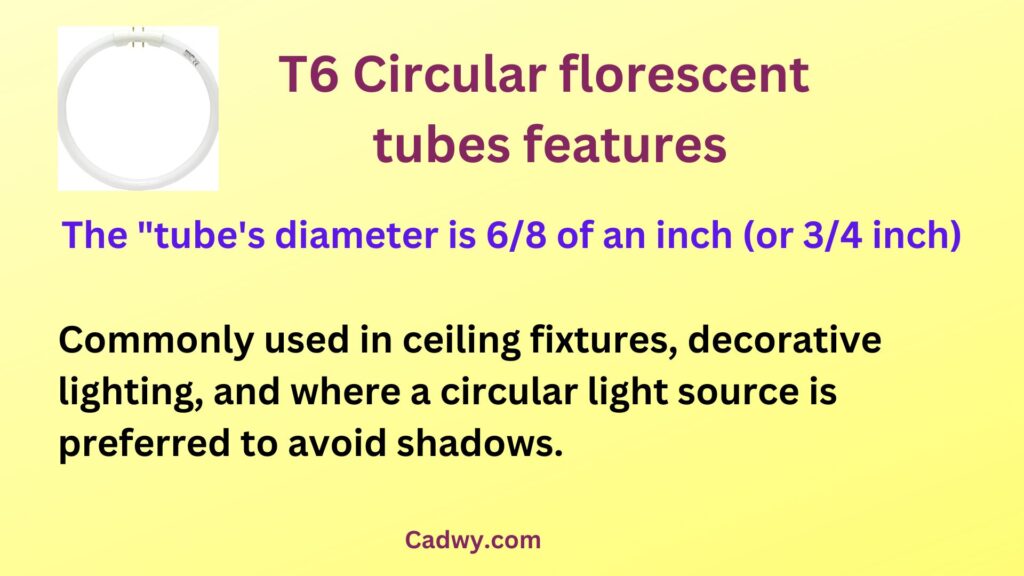
- A T6 circular fluorescent tube is a type of fluorescent light bulb that is circular in shape. The “tube’s diameter is 6/8 of an inch (or 3/4 inch). The circular shape allows for even light distribution.
- Lifespan: They have a relatively long lifespan, typically lasting thousands of hours, which reduces the need for frequent replacements.
- Applications: Commonly used in ceiling fixtures, decorative lighting, and where a circular light source is preferred to avoid shadows.
T9 Circular florescent tubes
- A T9 circular fluorescent tube is a type of energy-efficient fluorescent light bulb with a circular shape and a diameter of 1.125 inches (9/8 inch).
- It provides uniform light distribution and is commonly used in fixtures where even lighting is needed.
- These tubes have a long lifespan, come in various color temperatures, and require a compatible ballast to operate. They are ideal for applications in homes, offices, and commercial spaces.
Coloured florescent tubes

Colored fluorescent tubes are fluorescent light bulbs that emit light in various colors instead of the standard white or daylight hues. Here are the key points about them:
- Types of Colors: Available in a wide range of colors including red, blue, green, yellow, pink, and purple. These colors are achieved through the use of different phosphor coatings on the inside of the tube.
- Applications: Commonly used in decorative and accent lighting, signage, party lighting, retail displays, and entertainment venues. They add visual interest and can create specific atmospheres or highlight certain areas.
U Bent florescent Bulbs or Tubes

These bulbs are bent into a U-shape. This design allows them to fit into compact fixtures where straight fluorescent tubes would be impractical.
- Sizes: Common sizes include 2-foot and 3-foot lengths, though the actual length when considering the U-bend is slightly less than these measurements.
- Base Types: They typically use bi-pin bases, similar to straight fluorescent tubes, allowing for easy replacement and installation in existing fixtures.
Black Light florescent tubes
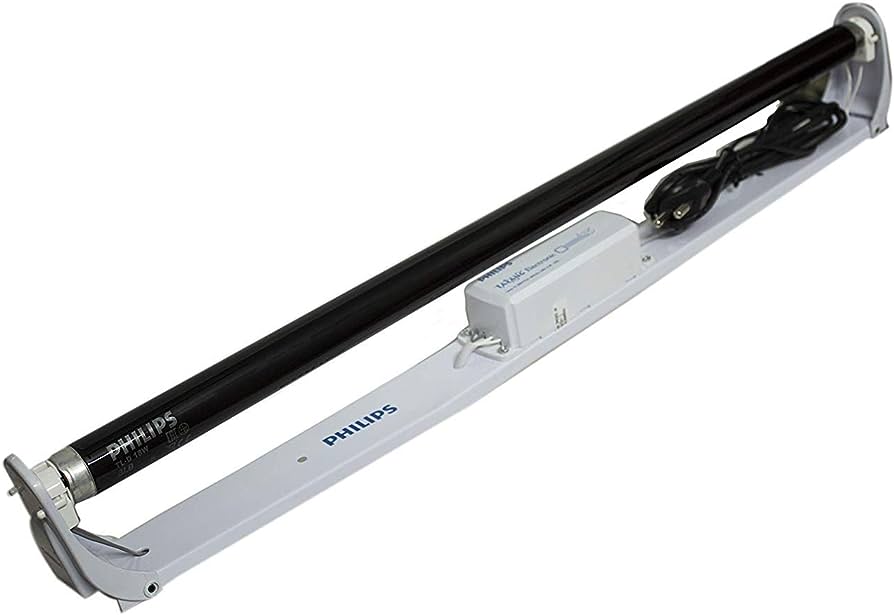
Black light fluorescent tubes, are specialized lighting devices designed to emit ultraviolet (UV) light, particularly in the UV-A range, which is between 320 and 400 nanometers. The inside of the tube is coated with a phosphor that emits UV-A light when excited by the mercury vapor discharge inside the tube. They are typically made from a dark blue or violet glass called Wood’s glass, which filters out most visible light and allows UV-A light to pass through.
Applications
- Forensic Science: Black lights are used to detect substances such as bodily fluids, which fluoresce under UV light, aiding in crime scene investigations.
- Art and Entertainment: They are popular in clubs, theaters, and amusement parks to create glowing effects with UV-reactive paints and materials.
- Inspection and Detection: Used for identifying counterfeit money, inspecting glassware for cracks, and detecting leaks in air conditioning and automotive systems with UV-reactive dyes.
- Healthcare: Employed in dermatology for diagnosing skin conditions and in sterilization processes, as UV light can kill bacteria and viruses.
Types of Black Light Fluorescent Tubes
- BL (Blacklight): These emit both UV-A and some visible blue light. They are commonly used in entertainment and decorative applications.
- BLB (Blacklight Blue): These are more specialized and filter out nearly all visible light, emitting almost exclusively UV-A. They are used in more precise applications like forensic analysis and non-destructive testing.
LED tubelights
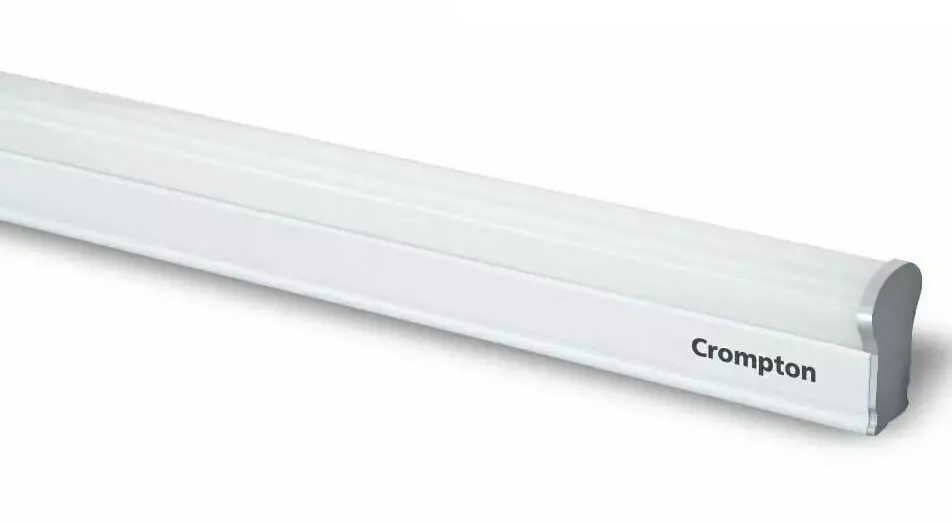
An LED tube light is a type of lighting fixture that uses Light Emitting Diodes (LEDs) to produce light. These tubes are designed to replace traditional fluorescent tube lights and offer several benefits, including higher energy efficiency, longer lifespan, and better light quality. LED tube lights come in various sizes and configurations to fit standard lighting fixtures and are commonly used in residential, commercial, and industrial applications.
Types of LED Tube Lights
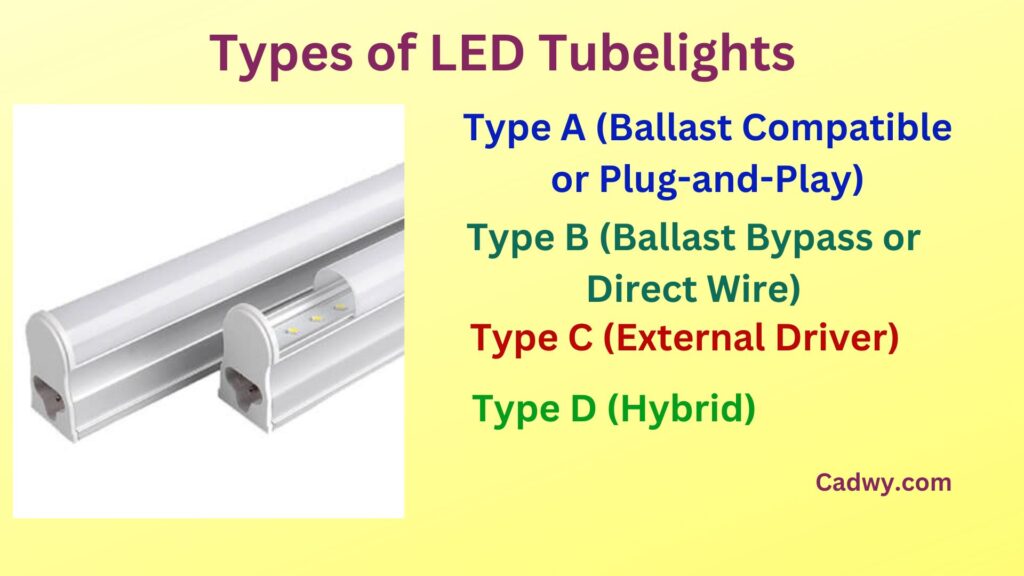
-
Type A (Ballast Compatible or Plug-and-Play)
- These are designed to work with the existing fluorescent ballast. They are the easiest to install as they simply replace the fluorescent tube without any rewiring.
-
Type B (Ballast Bypass or Direct Wire)
- These require the existing ballast to be removed and direct wiring to the power source. They are more energy-efficient as they bypass the ballast.
-
Type C (External Driver)
- These use an external driver to power the LEDs, similar to how integrated LED fixtures work. They often offer the best performance and longest lifespan.
-
Type D (Hybrid)
- These are versatile tubes that can operate with or without a ballast. They provide the flexibility to start with a plug-and-play setup and later switch to a direct wire configuration.
Advantages of LED Tubelights over conventional Florescent tube lights
- Energy Efficiency: Use significantly less energy, leading to lower electricity bills.
- Longer Lifespan: Last up to 50,000 hours or more, reducing the need for frequent replacements.
- Instant On: Provide immediate full brightness without flickering or warm-up time.
- Better Light Quality: Offer higher Color Rendering Index (CRI) and various color temperatures.
- Environmentally Friendly: Contain no hazardous materials like mercury and are easier to dispose of.
- Durability: More robust and less prone to breakage compared to glass fluorescent tubes.
- Heat Emission: Generate less heat, reducing cooling costs and risk of burns.
- Maintenance: Lower maintenance costs due to longer lifespan and reliability.
- Compatibility: Easily compatible with dimmers and smart lighting controls.
- Safety: Reduced risk of fire hazards and burns due to lower heat emission.
Manufacturing process of florescent tubelights
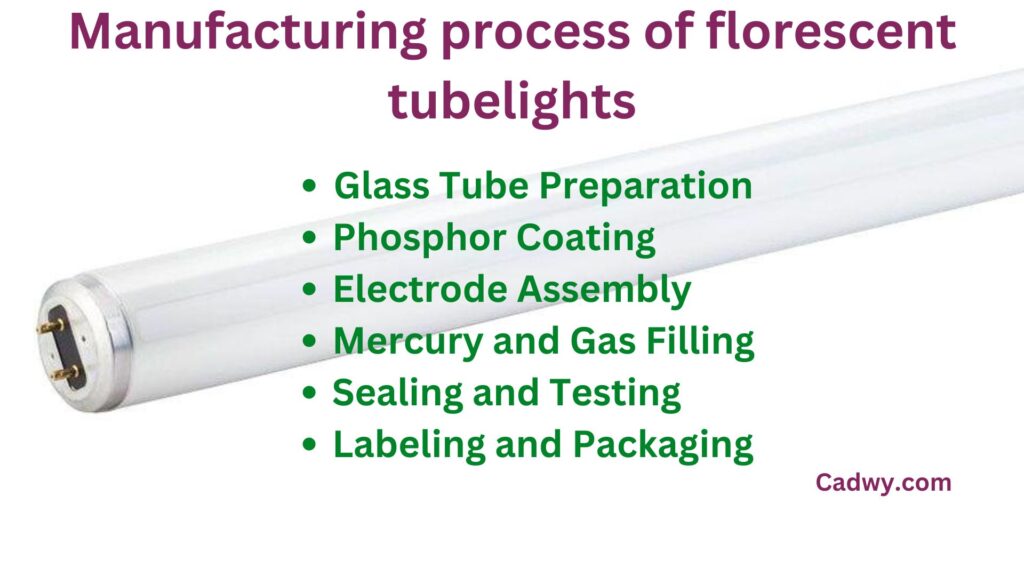
Here is the step wise process used to manufacture florescent tubelights in a factory-
- Glass Tube Preparation:
- Glass tubes are cut to the desired length and cleaned thoroughly.
- Phosphor Coating:
- The inside of each tube is coated with phosphor, then dried and baked to ensure it adheres properly.
- Electrode Assembly:
- Electrodes are inserted and sealed at both ends of the tube.
- Mercury and Gas Filling:
- The tubes are evacuated of air, filled with a precise amount of mercury, and an inert gas (like argon) is added.
- Sealing and Testing:
- The tubes are sealed, aged (operated for stabilization), and tested for quality control.
- Labeling and Packaging:
- The final tubes are labeled and packaged for distribution.
Manufacturing process of LED tubelights
The manufacturing of LED tube lights is a lengthy process that includes the following steps:
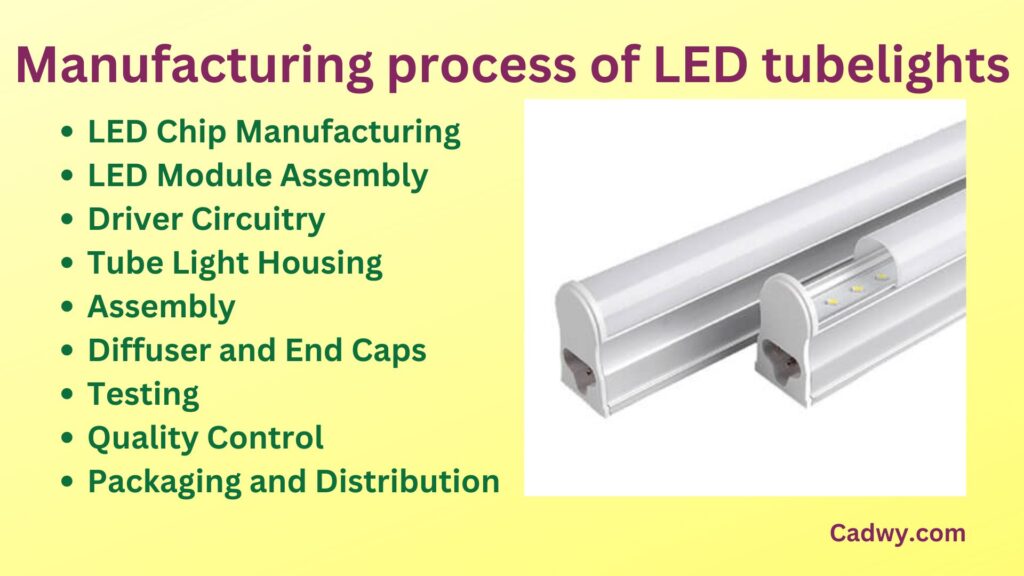
- LED Chip Manufacturing
- Material Preparation: Use semiconductor materials like gallium nitride.
- Epitaxy: Grow semiconductor layers on a substrate.
- Photolithography: Create patterns using UV light and etching.
- Packaging: Connect and encapsulate the LED chips.
- LED Module Assembly
- Mounting: Attach LEDs onto a Printed Circuit Board (PCB) using Surface-Mount Technology (SMT).
- Soldering: Secure the LEDs with reflow soldering.
- Driver Circuitry
- Design and Mounting: Design the power regulation circuit and mount it on a PCB.
- Tube Light Housing
- Material Preparation: Use materials like polycarbonate or aluminum.
- Heat Sinks: Integrate aluminum heat sinks for thermal management.
- Assembly
- Inserting LEDs: Place the LED module and driver into the tube housing.
- Wiring: Connect electrical components.
- Diffuser and End Caps
- Attach Diffuser: Add a diffuser for even light distribution.
- End Caps: Attach end caps with connection pins.
- Testing
- Electrical and Performance Tests: Check functionality, light output, and heat management.
- Quality Control
- Inspection: Conduct visual and mechanical inspections.
- Burn-In Testing: Perform long-term tests to ensure reliability.
- Packaging and Distribution
- Packaging: Protect and label the products.
- Shipping: Distribute to retailers or customers.